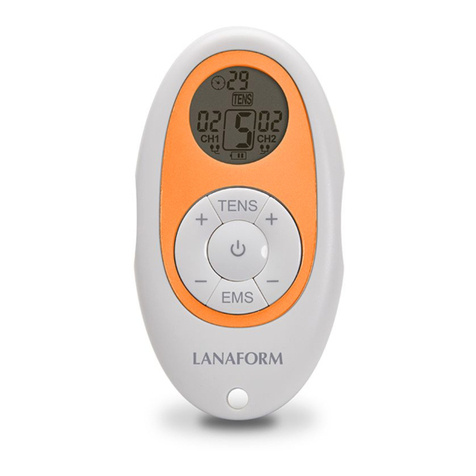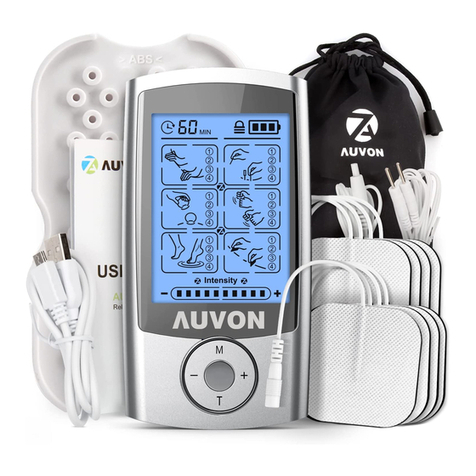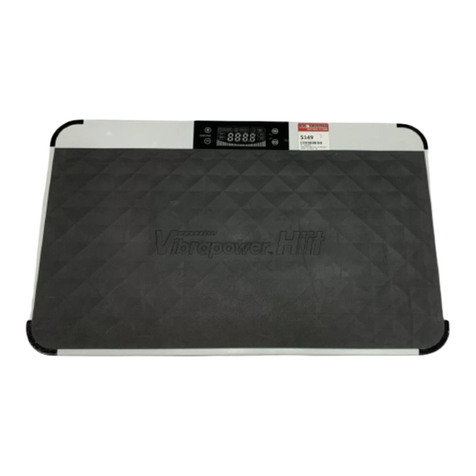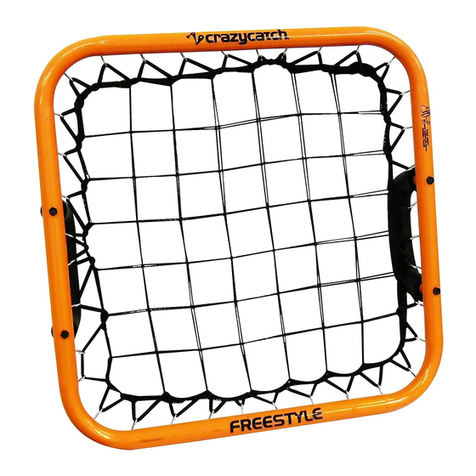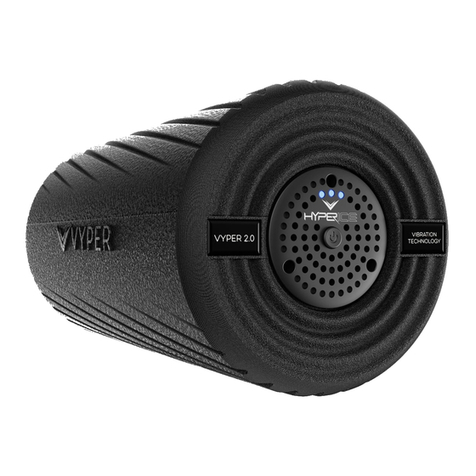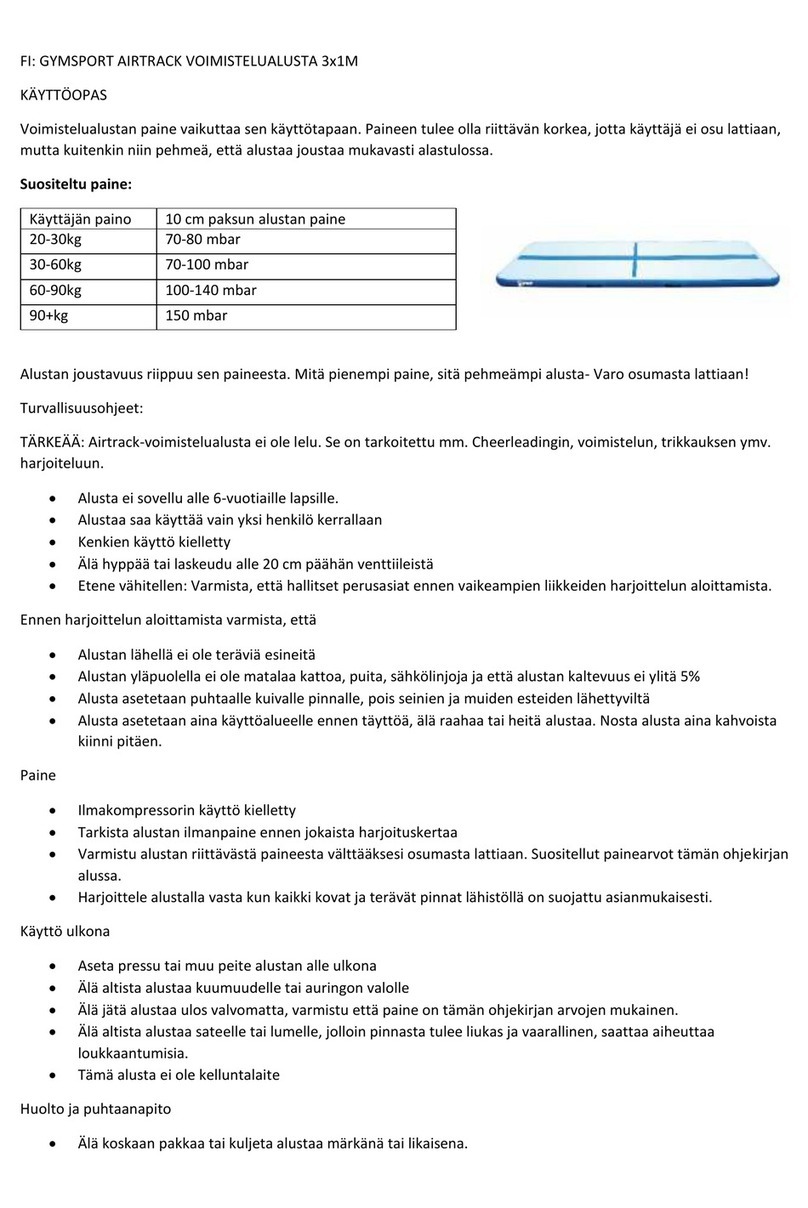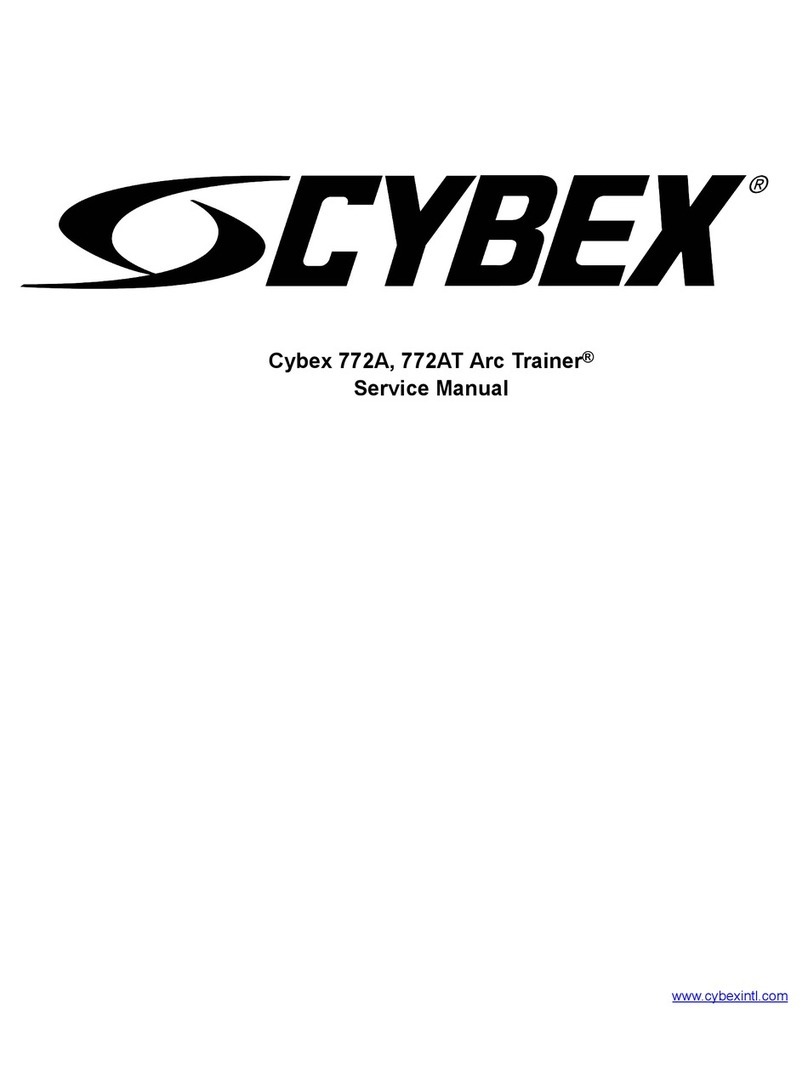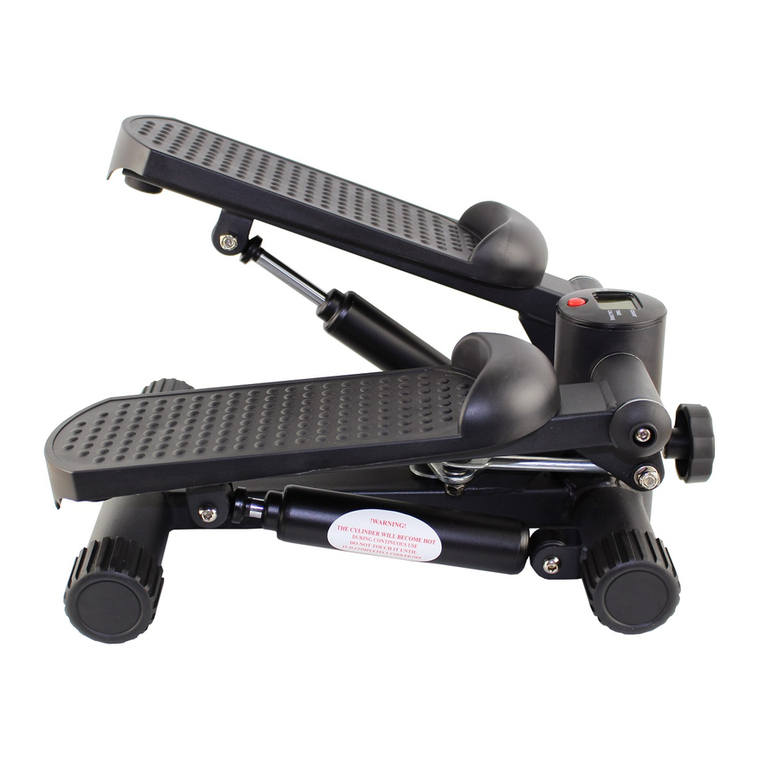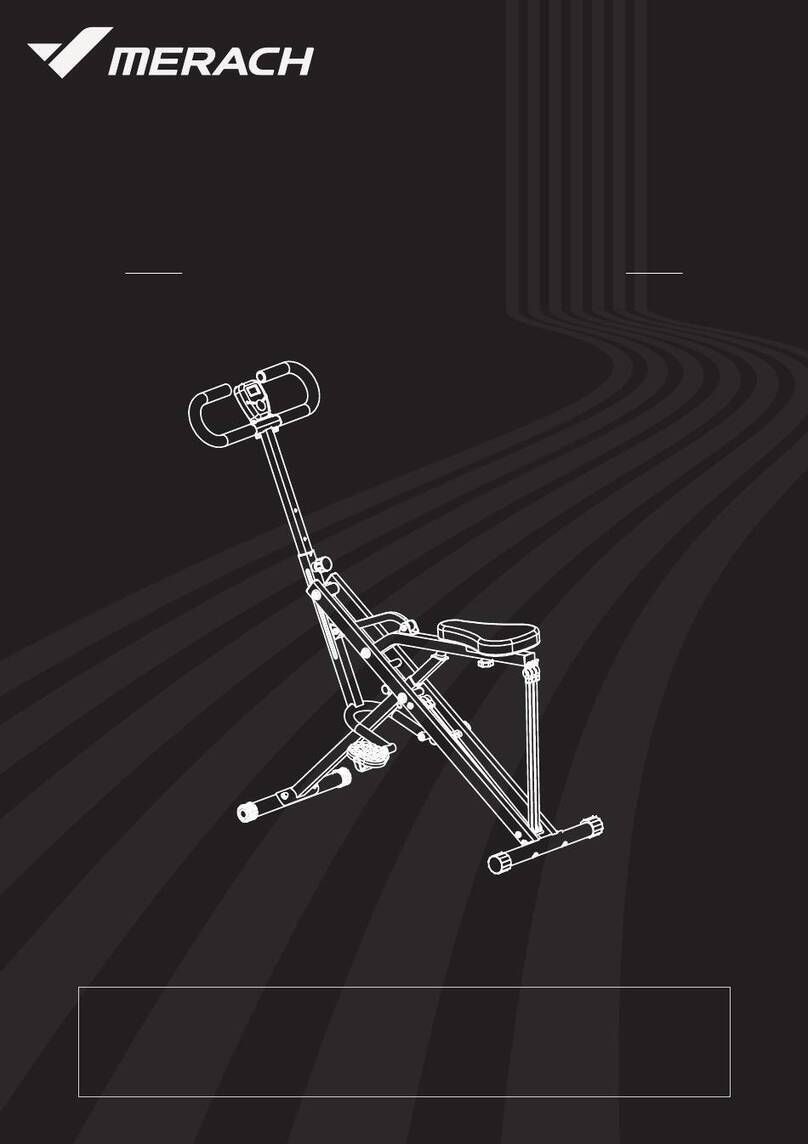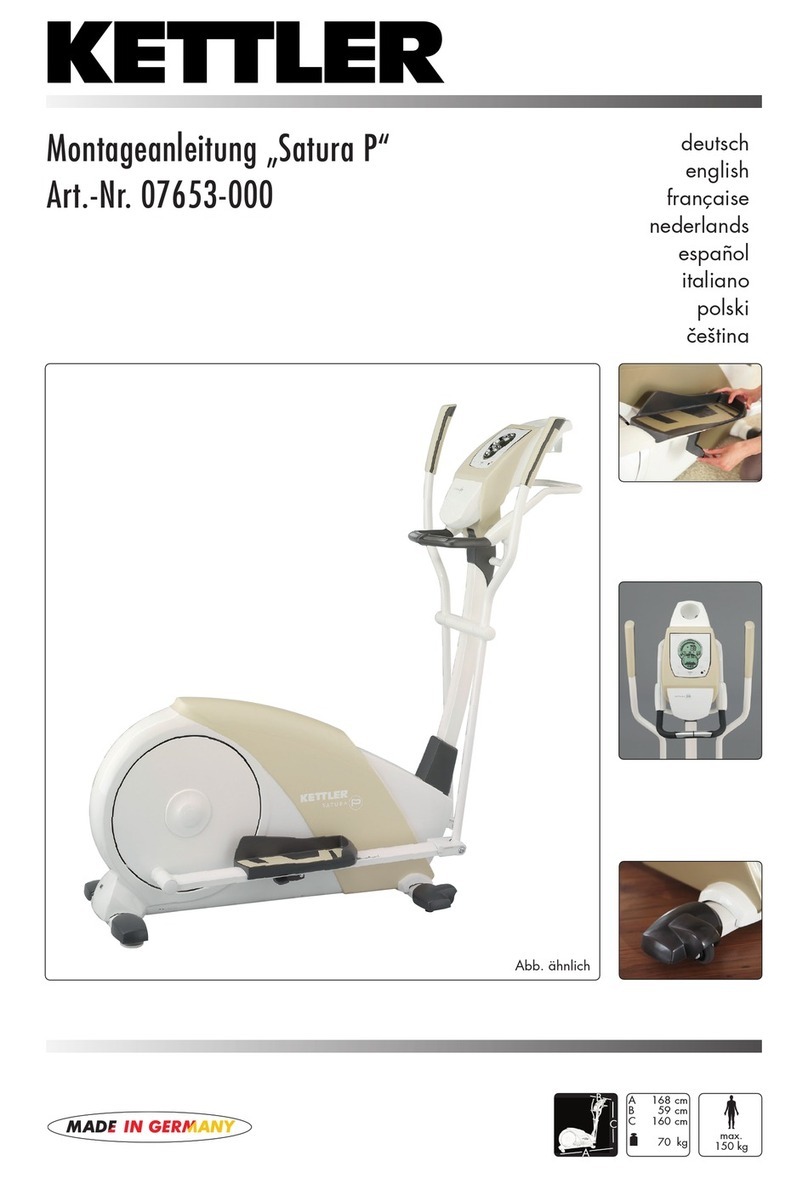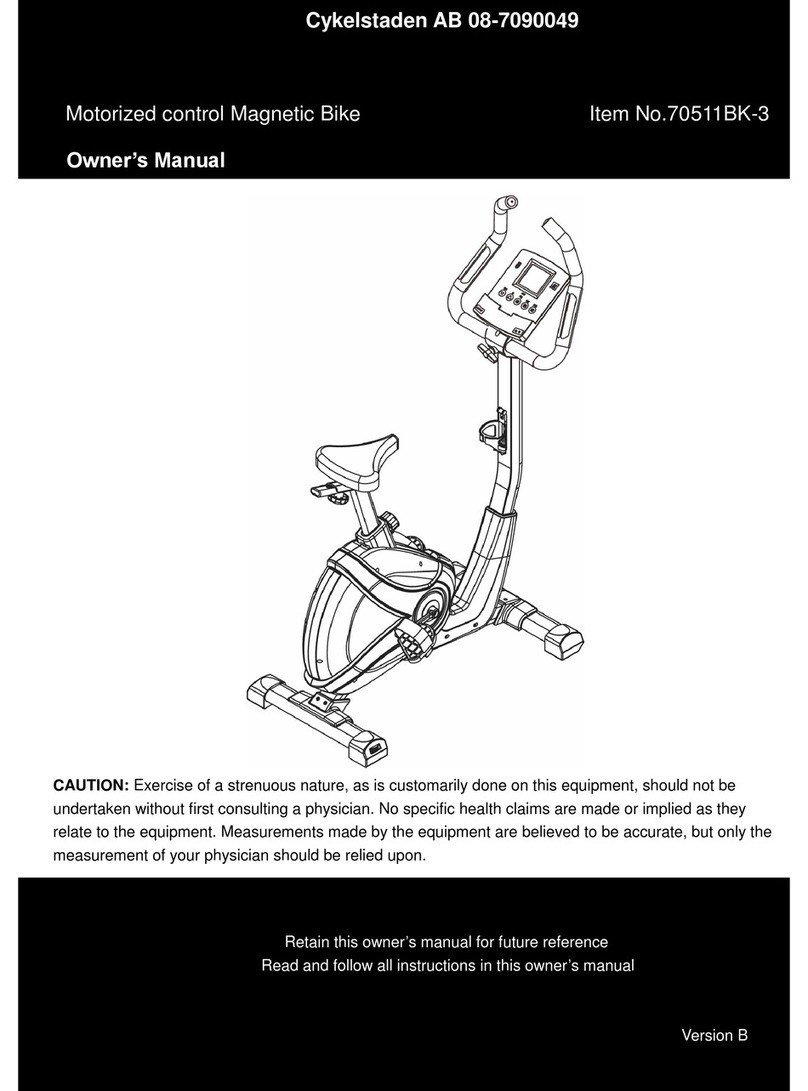Thought Technology MyoTrac T4000P User manual

5 2 5 0 F e r r i e r, s u i te 8 1 2
M o n tr e a l , Q u e b e c , H 4 P 1 L 3
C a n a d a

i
The Manufacturer
Thought Technology Ltd.
5250 Ferrier, Suite 812
Montreal, Quebec
Canada H4P 1L3
System Name
MyoTrac™ EMG Biofeedback System
System No.
T4000P/T4001P
Device Name
MyoTrac™ Biofeedback Unit
Device No.
SA4000P/SA4001P
EC
REP
EMERGO EUROPE
Prinsessegracht 20
The Hague, 2514 AP
The Netherlands

ii
Type BF Equipment
Internally powered equipment
Continuous operation
Read Instruction
CAUTION
RxOnly
US Federal Law restricts this device to sale by or
on order of licensed health care practitioners.
WARNING
Do not operate MyoScan sensor within 10 feet of
an operating cellular phone, similar radio
transmitting device, other powerful radio
interference producing sources such as arc
welders, radio thermal treatment equipment, x-ray
machines or any other equipment that produces
electrical sparks etc.
Radiated radio frequency electromagnetic fields
can cause performance degradation in the
MyoScan sensor. In the worst case, a RF field
strength of 22mV/M can cause a degradation of
1V in the signal from the MyoScan sensor. Be
sure to keep in mind that a very relaxed muscle
should provide an EMG reading of approximately 1-
3V.
Do not connect inputs or outputs of the encoder or
sensors to line powered devices.
All MyoTrac units are totally isolated from line (110
or 220VAC) power due to battery operation.
However, many hospitals and the FDA require that
computers, printers and any other equipment used
with medical devices be electrically isolated from
line voltage to UL or CSA medical safety standards.

iii
After use, the Disposable Electrodes may be a
potential biohazard. Handle, and when applicable,
dispose of these materials in accordance with
accepted medical practice and any applicable local,
state and federal laws and regulations.
Do not use in the presence of a flammable
anesthetic mixture with air or with Oxygen or
Nitrous Oxide.
Not to be immersed in water.
ATTENTION
To prevent static discharge from damaging the
sensor and/or encoders, use anti-static mats or
sprays in your working area. A humidifier may also
be used to prevent static environments by
conditioning hot, dry air.
To prevent voiding warranty by breaking connector
pins, carefully align white guiding dot on sensor
plug with slot on sensor input.
Do not apply any electrode gel or equivalent directly
on the sensor snaps. Apply conductive gel only to
electrodes. Always use electrodes as a medium
between the sensor and the client.
Make sure to remove electrodes from sensor snaps
immediately after use.
Do not plug third party sensors directly into
instrument inputs. Plug only Thought Technology
Active Sensor cable connectors into instrument
inputs. All EMG electrodes and third party sensors
must be connected to MyoScan sensors, either
directly or through an adapter.
Remove batteries when the device is not being
used for extended period of time. Please dispose of
battery following national regulations.

iv
Sensors damaged by static electricity are not
covered under warranty! In dry climates, apply anti-
static spray on carpets each week and/or use a
conductive floor mat (available from computer
stores).
CONTRAINDICATIONS
None
INTENDED PURPOSE
Biofeedback, Relaxation & Muscle Re-Education
purposes.
NOTE
No preventative inspections required. Maintenance
must be performed by qualified personnel.
STORAGE
Store in its original case.
Temperature
-23 - +60C
Humidity
10% - 90%
Atmospheric pressure
70 –106kPa
TRANSPORTATION
Transport in its original case.
Temperature
-23 - +60C
Humidity
10% - 90%
Atmospheric pressure
70 –106kPa
Manual No. SA9601 Rev.9 (April 2019)
© copyright Thought Technology Ltd.2019

v
Model No. MyoTrac (4000P 60Hz)
Model No. MyoTrac (4001P 50Hz)
Table of Contents
Introduction............................................................................ 1
Installing and Testing Your Battery........................................ 2
Trying Your MyoTrac for the First Time.................................. 4
Use of the MyoScan™ Sensor............................................... 4
Front Panel Controls.............................................................. 8
Battery Compartment Controls .............................................. 8
Side Panel Jacks ................................................................. 10
Setting the Threshold Potentiometer ................................... 11
Connecting to a Voltage Monitoring Device......................... 13
Care of Your Instrument....................................................... 13
Specifications....................................................................... 15
Accessories.......................................................................... 16
Warranty .............................................................................. 17
Extended Warranty Program ............................................... 18
Repair Return Form ............................................................. 19
Other Products and Services............................................... 20

1
Introduction
Biofeedback is a rapidly developing scientific field that has grown
out of advances in physiology, psychology and electronics.
Ordinarily, we are unaware of the subtle internal body activities that
are part of our everyday lives. Biofeedback uses sensitive
electronics to detect and amplify theses activities in order to bring
them to awareness. By allowing us to observe these activities,
biofeedback also allows us to learn to modify them. Since we are
immediately aware of the outcome of our attempts, we can
gradually learn to produce the results we desire.
Muscles go through a wide range of activity. Normally, we are only
aware of the muscle activity associated with movement, such as
occurs in swinging a tennis racket. Yet much muscle activity
produces no visible movement and, as a result, goes unnoticed.
EMG (electromyographic) activity is a measure of the electrical
activity in the muscles. Since the electrical activity of the muscle
increases when the muscle is tensed and decreases when it is
relaxed, EMG biofeedback can provide information about the state
of relaxation or tension of our muscles.
Our muscles respond to threatening, stressful situations with large
increases in tension. This response is part of an old reflex left over
from a time when one had to either fight or flee from a stressful
situation in order to survive. Today, fighting or running isn't
generally appropriate. So, in most stressful situations, there is
increased muscle tension, which cannot be dissipated by fighting or
fleeing. If this high tension continues, muscle fatigue, soreness, or
even pain may result.

2
Work with EMG and relaxation and tension began during the
1920's and 1930's through the pioneering efforts of Edmund
Jacobson. Jacobson found that the more relaxed a muscle was, the
lower its EMG activity level was. He also noted that this lowered
EMG activity level was associated with a more general subjective
sense of relaxation.
EMG biofeedback is also being applied very successfully in
rehabilitation medicine - such as in regaining control of lost muscle
function, re-establishing the correct relationship between agonist
and antagonist muscles, relaxing spasmodic activity and in
strengthening weak or atrophied muscles.
While Jacobson's work marked a milestone in EMG research, his
methods of measuring EMG were crude and cumbersome by today's
standards. The MyoTrac represents a tremendous step forward in
EMG technology. Thanks to solid state electronics and micro
circuitry, equipment which used to fill a laboratory in Jacobson's
time can be replaced today by the MyoTrac - small enough to fit in
the palm of your hand.
Installing and Testing Your Battery
Battery Insertion: We strongly recommend the use of an alkaline
or lithium 9 volt battery. You can use a rechargeable nickel-
cadmium (NiCad) battery, but keep in mind that although NiCad
batteries can be charged many times, they last only about one
quarter as long in operation as an alkaline battery.
To insert or remove the battery, hold the device in one hand and
firmly grasp the sides of the battery compartment lid with the other.
Pull straight towards the rear of the case to slide it off. (See Figure
1.) Replace the battery, being careful to observe the proper polarity.
Slide the lid back in place, pushing gently to snap the clip.

3
Fig. 1 Opening the battery compartment
Note: Remove old batteries promptly to prevent corrosion. Remove
the battery if the device is not going to be used for periods longer
than one month.
Testing the Battery: To check the battery, turn the unit on, place
the threshold potentiometer to 5, and the scale-reading switch to x1.
With a Triode electrode snapped on the MyoScan sensor, place the
sensor over a muscle and tense it.
If the first yellow LED in the middle of the bar graph does not light
as the LEDs go from left to right, then change or recharge the
battery.
MyoTrac (SA4000P & SA4001P)

4
Trying Your MyoTrac for the First Time
Plug the MyoScan sensor into the INPUT jack. Set the switches
inside the battery compartment to: OFF, OFF, ABV, NAR (fig. 7).
Set the gain switch to the x1 position. Turn the volume up. Set the
threshold potentiometer to 10 (fig. 6).
Snap a Triode electrode on the three MyoScan connectors (fig. 2).
Hold the MyoScan sensor on your cheek with a light pressure,
placing it just below the cheekbone (over the temporomandibular
joint). Make certain that all three electrodes contact the skin.
Observe the tone and bar graph reading as you tense and relax your
jaw by clenching your teeth.
When the first yellow LED lights up, the actual EMG reading
corresponds to the threshold value that is set on the THR. Dial, in
this case, 10
V.
Use of the MyoScan™ Sensor
The MyoScan sensor incorporates sensitive electronic circuitry to
amplify the minute EMG signals directly under the electrode
connectors so that the MyoTrac readings will not be affected by
cable movement or outside electrical interference. For the MyoScan
sensor to function properly, electrodes must be inserted on the
sensor head. There are several choices of electrodes which can be
used, depending on the muscle site to be monitored. The disposable
Triode electrodes will be adequate for most applications.
Disposable Triode Electrodes (T3402M): Disposable electrodes
avoid cross contamination of patients. The foam-backed triangular
Ag-AgCl (silver-silver chloride) Triode electrodes can be used for
scanning most muscle sites for activity. Remove the back covering
exposing the adhesive to firmly hold the MyoScan sensor in place
(see figure 2).

5
Generally, no skin surface preparation is required; however, for
guaranteed stability over very dry or hairy areas, clean the target
site with an alcohol wipe or apply a tiny dab of electrode gel to each
electrode. Be careful to avoid applying the electrode gel to the skin
between electrodes, which could interfere with the signals.
Thought
Technology
REF
Triode
#T3402M #T3425
Fig. 2 Triode and Uni-Gel electrodes
For measuring EMG activity over specific muscle sites which are
not suitably monitored by the triangular configuration, or where a
wide placement is required, an extender cable can be used.
Extender Cable (T8720M): Thought Technology's 450mm
extender cable can be inserted directly into the sensor head (figure
3), being careful to align the alignment dot on the cable connector
with the groove on the sensor head.
Electrode ButtonsSensor Head
Align the groove
with the dot
Thought
TechnologyLtd.
Fig. 3 Extender Cable
When an extender cable is used, Disposable Uni-Gel Electrodes
(T3425) are snapped in the three electrode buttons. (See figures 2
and 3).

6
Note: To remove the electrodes, hold the sensor or the extender
cable button with one hand, place the index finger of the other
hand on the electrode and slide the thumb nail between the
electrode and the electrode snap, pry the electrode gently out of the
snap.
Sensor placement: Generally, the sensor is placed on a muscle site
so the two active electrodes are positioned parallel to the muscle
fibers (i.e. placed in line with them). (See figure 4.)
Active electrodes
Reference
electrode
Muscle fibers
Active electrodes
Fig. 4 Sensor Placement
Sensor jacks and plugs:
Plugs and jacks with protected pins:
Thought Technology has developed its
own patented gold plated protected pin
system for all sensor and encoder plugs
and jacks.
The protected pins are designed to prevent any possibility of direct
skin contact with the metallic elements that conduct the amplified
signals. They also help prevent accidental damage from attempting
to plug Thought Technology sensors and encoders to equipment for
which they were not designed.

7
Replacement Sensor Cable (Model T9385M)
Thought Technology sensors use a highly flexible and lightweight
cable. If, for any reason, a break should occur in the cable, a
replacement cable is available.
Model No.SA9385M
To change cables, tightly grip the connector plugged into the
MyoScan with your thumb and index, and pull gently on the
connector. Do the same at the other end to remove the cable from
the encoder. Replace the cable with a new one.
Be very careful to align the notch on the cable connector with the
guiding groove on the sensor head or the encoder, since the plug
will align in only one direction. (See figure 5.)
Guiding Notch and Groove
Fig. 5 Cable Connectors

8
Front Panel Controls
The front panel (see figure 6) includes controls for sound level
(VOLUME), threshold level (THR), three gain settings, x1, x10
and x100 for ranges of .08-20, .08-200 and .08-2000 microvolt
(V) RMS, respectively. A power switch lets you select OFF and
either continuous proportional tone feedback (CONT) or threshold
feedback (THR).
MyoTrac (SA4000P & SA4001P)
Fig. 6 Front Panel
Threshold feedback allows you to set control parameters for the
tone feedback to be enabled or disabled when the EMG signal
exceeds or falls below the threshold setting of the threshold control.
The various threshold functions are chosen from the switch settings
in the battery compartment.
Battery Compartment Controls
Within the battery compartment are switches to set a variety of
choices as follows. (See figure 7.)
WIDE/NAR band-pass (20-500 Hz. or 100-200 Hz.): Sets the
frequency range for signal detection. The 20-500 HZ. range
detects a wider range of EMG signals, but is also prone to
cardiac (EKG) interference. For this reason, it is not
recommended for monitoring sites on the back or torso.

9
ABV/BLW: This switch determines if the tone feedback is turned
on when the signal exceeds (ABV) or falls below (BLW) the
threshold potentiometer setting.
CUE TONE/OFF: When either the 4 or 60 second switch is set,
and the threshold is exceeded for at least 4 or 60 seconds, a
continuous (not proportional) cue tone will sound. This cue
tone will sound as long as the signal stays above threshold. As
soon as the signal drops below the threshold, the cue tone
turns off. If the threshold is exceeded again for 4 or 60
consecutive seconds, the cue tone will start once more.
Note: CUE does not work with the BLW setting.
LOCK/OFF: Works only with cue tone (CUE) on. LOCK locks on
a continuous high-pitched tone to cue the user that the
threshold level has been exceeded (if set ABV), for more than
4 or 60 seconds. Once the cue tone has been triggered on, it
can only be canceled by moving the front panel power switch
to the CONT or OFF positions.
Fig. 7 Battery Compartment Controls

10
The three threshold switches, LOCK/OFF, CUE TONE/OFF and
BLW/ABV are only functional when the front panel power switch
is set to THR. Possible combinations are:
LOCK/OFF
CUE/OFF
ABV/BLW
1
OFF
OFF
ABV
Proportional tonefeedbackabovethreshold.
2
OFF
OFF
BLW
Proportional tonefeedbackbelowthreshold.
3
OFF
CUE TONE
4 or 60 sec.
ABV
CuetonewhenEMGabovethresholdfor>
4or60seconds.(Goesoffimmediately
when EMGgoesbelowthreshold).
4
OFF
CUE TONE
BLW
Notavalidposition.Cuetone(CUETONE)
worksonlyforabove(ABV)threshold
position.
5
LOCK
CUE TONE
ABV
Sameascondition 3;however the tone
locksonuntil thepowerswitch
(OFF/CONT/THR)isturnedoff.
6
LOCK
CUE TONE
BLW
Notavalidposition.
7
LOCK
OFF
ABV
Not avalid position.
8
LOCK
OFF
BLW
Not avalid position.
Side Panel Jacks
(see figure 8)
INPUT: Plug the MyoScan sensor in here.
Plugging the earphones in here disconnects the internal
speaker and sends tone feedback through the earphones.
0-2V: Provides a 0-2 Volts output signal. The MyoTrac can be
connected to other third party device with an isolated voltage input
that accepts 0-2V. Make certain the instrument complies with IEC
601-1.
Note: This output is the same for all the gain settings. An output
value of 2 Volts will represent 20
V at the x1 setting, 200
V at
x10 and 2000
V at x100.

11
Fig. 8 Side Panel Jacks
WARNING: Never connect your MyoTrac to
an A.C. powered device!
Setting the Threshold Potentiometer
The threshold control’s main function is to set a goal value for the
EMG signal. When that value is reached, the tone is heard, which
provides immediate feedback to reward or inhibit a particular
behavior. This control can also be used to place the EMG signal at a
desired point on the bar graph, moving it right or left by turning the
knob.
It is also possible to determine the exact EMG reading in micro
Volts. As previously mentioned, when the signal is at the first
yellow LED, EMG activity corresponds to the threshold setting.
The left-most LED indicates one-half the threshold value and the
right-most LED is twice the threshold value.

12
The Gain setting determines the reading range: 0-20 V at x1, 0-
200 V at x10 and 0-2000 V at x100. For each gain setting, the
possible threshold values are: .5-10 V (x1), 5-100 V (x10), and
50-1000 V (x100) respectively.
Example of Threshold Setting:
If you want to do a feedback session for the purpose of encouraging
an increased level of activity in a specific muscle, initially set the
gain to x1. If, with a normal contraction, the reading is near the left
end of the green scale, then you might want to set the threshold
control to a lower number (turn the knob clockwise); this will move
the signal toward the right, making it easier to reach the threshold.
Conversely, if the reading is at the top of the scale (all the way to
the right), you might want to increase the threshold (turn the knob
counterclockwise) to move the signal to the left. If this is not
sufficient, you can increase the range by switching the scale reading
switch to the x10 or x100 position.
Let’s say that the THR dial is set to 5and the gain switch to x10.
The first yellow LED would represent 50 V (5 x10), the left most
green LED would be 25 V and the right most yellow LED, 100
V.
MyoTrac (SA4000P & SA4001P)
25 V 50 V 100 V

13
Connecting to a Voltage Monitoring Device
Connect the 0-2V output jack (see figure 8) to any instrument
capable of reading from 0-2 Volts (digital voltmeter, analog
voltmeter, polygraph, integrator, etc.). Make certain the instrument
is battery operated or complies with IEC 601-1. The output voltage
will always be in the 0-2 Volt range; however, the actual EMG level
in microvolt RMS is dependent upon the Gain setting. Range values
are obtained by multiplying the output voltage reading as follows:
Switch = x1, multiply by 10
Ex: Voltage = 0.9; EMG = 9 V
Switch = x10, multiply by 100
Ex: Voltage = 1.5; EMG = 150 V
Switch = x100, multiply by 1000
Ex: Voltage = 1.1; EMG = 1100 V
Care of Your Instrument
Basically, no maintenance, other than cleaning, is required.
Any surfaces which come in contact with skin should be cleaned
after each use by wiping with a damp cloth. If conductive gel is
used, be careful not to apply any gel on the sensor head. If gel gets
inside the sensor’s electrode connectors, clean immediately with a
moistened cotton swab to remove the gel.
IMPORTANT POINTS TO REMEMBER:
Protect from static electricity:The MyoTrac and MyoScan
are sensitive electronic instruments, and should be handled as such.
Damage can occur if used in dry, carpeted areas without a static mat
or a static guard product sprayed on the carpets.

14
Connect and disconnect with care: When unplugging the
sensor from the MyoTrac or the sensor cable from the sensor head,
be careful to avoid pulling on the cable. Instead, grip the connector
firmly and pull straight out. Always make sure to align the notch on
the cable connectors (indicated by a dot) with the guiding groove.
Never force a connector in the socket.
Always remove the electrodes: Do not leave the electrodes
connected to the sensor head when the device is not in use as this
could cause corrosion damage to your equipment.
Remove batteries promptly: The MyoTrac is battery operated.
To prevent corrosion damage due to battery leak, remove battery
when not in use for long periods of time and when battery is old.
This manual suits for next models
1
Table of contents
